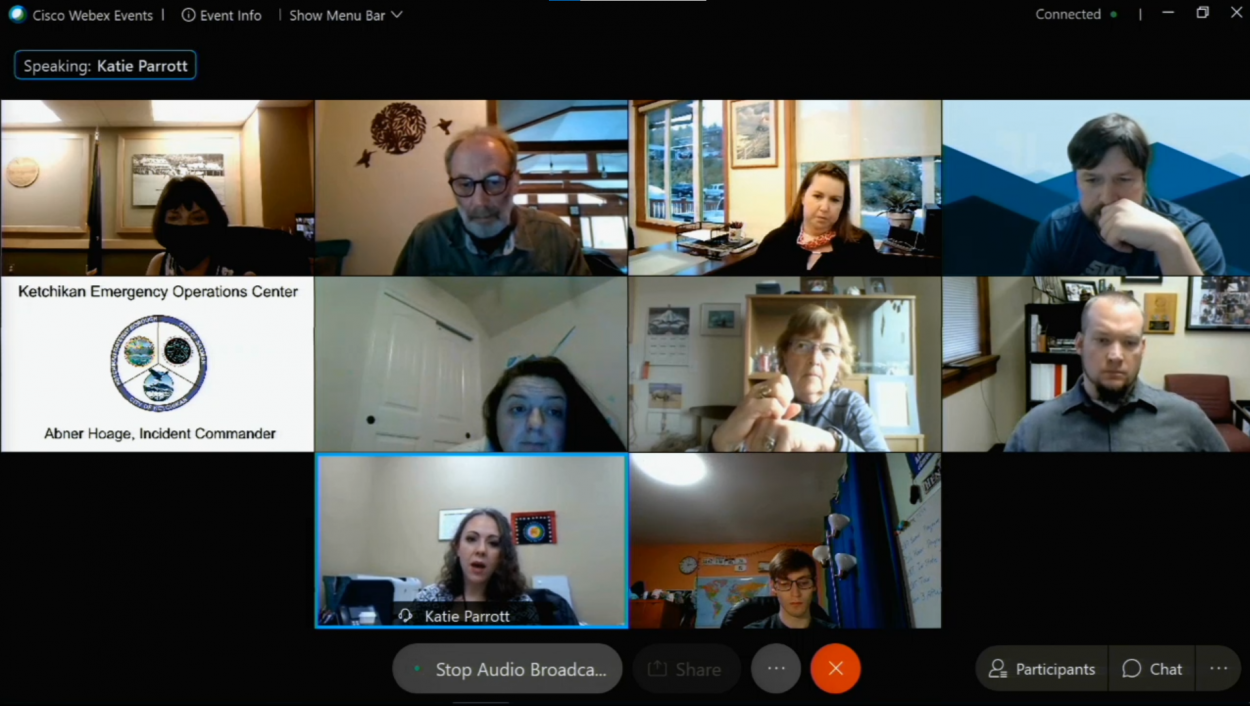
Ketchikan’s school board met virtually Thursday to consider bringing students back to full-capacity classrooms. (Screenshot: Eric Stone/KRBD)
Most of Ketchikan’s secondary school classrooms will remain half-full for another week as the area’s pandemic risk level remains elevated. But some school board members pushed to fully reopen schools despite emergency officials’ advice.
Back in July, a 5-2 majority of Ketchikan’s school board voted to bring students back at 100% capacity five days a week. The vote followed months of contentious debate and hours of public testimony from parents, teachers, community members and pandemic response officials.
Here’s board member Paul Robbins, Jr. speaking at that July 29 meeting:
“Madam President, I motion that we vote to adopt the Smart Start plan as a contingency for the 2020-2021 school year and that the school year begin under the minimal risk scenario,” he said.
Basically what that meant was that instruction would be 100% in-person — no Zoom, no distance learning. But classrooms could be scaled back if COVID-19 cases spiked.
That’s been the plan. And it was reaffirmed by four school board members who won new terms in October’s local elections: if Ketchikan’s emergency operations center, or EOC, said students should be sent home, they’d be sent home.
Here’s Kim Hodne, currently the school board president, speaking at a KRBD forum in September.
“Well, it would be ignorant to ignore a suggestion from our local emergency operations center if they’re giving us a recommendation and they’re basing it – which I know that they would – on what is happening in Ketchikan,” he said at the time. All six candidates pledged to follow the EOC’s recommendations.
But when the board met Thursday, Hodne said he wasn’t convinced that schools should remain half-empty.
He argued that existing precautions were enough to slow the spread even with full classrooms.
“We have many protocols in place, distancing and masking, and all of that. And if all those protocols are in place, and it works, then 50-50 really is no different than 100%,” Hodne said Thursday.
Board member Diane Gubatayao said she agreed.
But cases have been climbing, including within the school district: three people at Schoenbar Middle School have tested positive in recent days, as have another three at Ketchikan High School, the acting superintendent told KRBD late Thursday.
That led the board majority to say they should play it safe. Secondary school would remain at half capacity.
Board member Paul Robbins Jr. was among the majority who argued for sticking with the district’s established plan.
“You know, we put a ton of work months and months and months of work into this Smart Start plan, which factored in the testimony of countless parents, the testimony of countless teachers, and the testimony of countless experts,” Robbins said Thursday.
The board voted 5-2 to keep Schoenbar Middle School, Ketchikan High School and Revilla Junior-Senior High School at reduced capacity through Feb. 26. Gubatayao and Hodne were opposed.
Speaking after the meeting, School board President Kim Hodne says the school district has broad autonomy to make its own public health decisions.
“We are not tied directly to the EOC’s risk levels, and we all know that. But we have followed them to this point. And I believe now, six months later, after having said that, with more information, changing of circumstances, it was, in my opinion, now it’s the right way to go,” Hodne said.
The school board is slated to reconsider whether to bring students back to classrooms at noon Thursday, Feb. 25. It’ll be broadcast on cable channels and streamed on the borough’s website.








